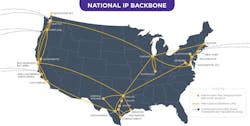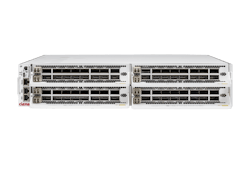Astound Business Solutions is enhancing its optical wavelength war chest with a new 400G Wavelength service to address the emerging capacity needs of large carriers, enterprises, and public sector agencies.
The new commercial service uses Ciena’s WaveLogic Extreme (WL5e) 800G and WaveLogic 5 Nano (WL5n) 400G coherent optics.
What potentially bodes well for Astound to gain momentum with the service is its wide-reaching network. Astound’s network covers over 41,000 route miles and provides connectivity for over 75,000 business customers and more than 100 data centers across the U.S.
The provider’s new service responds to its multi-site business customers and the need to access cloud services out of data centers. A key driver of 400G wavelength service adoption is more incredible connectivity speeds between multiple locations and meeting the demand of data center providers’ higher-speed requirements.
Patrick Knorr, Chief Commercial Officer for Astound Business Solutions, said its focus with 400G and any product it offers is to right-size them to its customers’ specific needs.
“We had a continual strategy to provide custom-oriented solutions,” he said. “We have done a lot of custom fiber construction projects for a range of partners, and optical capacity is an extension of that.”
Still, Astound realizes that 400G isn’t a fit for everyone. “Our focus is to try to be as customer-centric as possible,” Knorr said. “We’re not going to convince every customer they need 400G, but we will ensure we have the right capacity platform to meet those needs.”
He added whether it is “Ethernet, IP/MPLS, high-capacity optical or dark fiber, our focus will be on providing the right solutions for any given customer’s unique objectives.”
400G wavelength service demands
Astound is seeing the demand for 400G across various customer segments, particularly health care and education.
“When you look at the enterprise segment, like the mid-market, they don’t have the need,” Knorr said. “If you look at health care, education, hyper scalers, and others doing high volume data between data centers are use cases, and all are talking about 400G on the roadmap.”
While Knorr admits that the current demand for 400G is not “massive,” the potential is like earlier iterations like 10G and later 100G. “The same thing was true for 10G and then 100G,” he said. “It always starts as a roadmap discussion, but we fully expect this will be the year 400G will accelerate.”
Overall, Wavelength circuits that provide Layer 1 dedicated bidirectional gigabit-speed optical fiber connections between two sites, like a multi-site enterprise or a data center, continue to gain momentum.
According to Vertical Systems Group, the critical driver for wavelength services is expanding the U.S. base of wavelength circuits driven by double-digit growth for 100+ Gbps connections through 2027. Billable installations of 400+ Gbps services are also emerging as wavelength providers expand availability and roll out new solutions.
Having offered wavelength services for several years, Knorr sees 400G “as the next step in capacity acceleration.”
Enabling education systems
Education is one of the leading applications that Astound Business Solutions will target, the new 400G wavelength service. Schools require secure, high-bandwidth connections across multiple campuses, offices, and districts.
The service provider participates in the Universal Service Administrative Company’s E-Rate program and assists its education customers in navigating the rules and regulations for securing funding for digital learning initiatives.
Knorr said the 400G service is another weapon in its arsenal that it can offer to an industry segment it has always served but wants to be able to evolve to meet future needs.
“We have been successfully supporting school districts for many years, and we see that as a sweet spot,” he said. “With 400G, we think it will initially emerge in the university and education service centers.”
Astound sees ongoing potential in distance learning. Distance learning, which became a reality for most students at all levels during COVID-19, continues.
“Distance learning is not going away,” Knorr said. “High-resolution video is being integrated into learning programs from the school district to the university level.”
The next opportunity for 400G and higher speed wavelength services could be with advanced solutions managed out of the education service center.
“These technology education hubs are places where they try to hub a lot of services in a central location to serve multiple school districts,” Knorr said. “We think those situations are where we’ll see the initial demand for this capacity.”
Next-gen optical focus
At the heart of Astound Business Solutions’ 400G service is Ciena’s Waveserver 5 interconnect platform. The platform leverages Ciena’s WL5e 800G performance-optimized coherent optics or WL5n 400G coherent pluggables to deliver 400G connectivity across all network links.
Also, the service provider is using Ciena’s flexible 6500 ROADM photonic layer for resiliency and scalability and its Navigator Network Control Suite (Navigator NCS) for multi-layer visibility and simplified network management.
Astound can accelerate its network build by leveraging Navigator’s PlannerPlus and Emulation Cloud, which provide online network planning and design tools and an open environment for integration testing with operational support systems.
“This enables us to deploy the right coherent technology for any distance at the lowest power and cost—whether that’s Ciena’s WL5e for longer-reach links or its WL5n for shorter ones,” said Knorr. “And, thanks to Navigator NCS, we can do the calculations well before any hardware is deployed.”
While Astound works with multiple vendors on its network, the Ciena platform's flexibility ensures it can serve 400G customers effectively.
"Ciena has the best-in-class solution for 400G, which has a good path to go to 800G,” Knorr said. “For the customers that need it, that’s going to be the next step, so it’s a very scalable solution.”
To ensure the Ciena platform could deliver customers 400G wavelength services, Astound was to deploy and initially leverage the network platform for its own internal needs.
Knorr said this helped test the platform. “The first step was deploying the platform in our networks,” he said. “It’s much better for us to be the first to deploy the platform.”
Astound will work with its internal team to leverage the Ciena platform. “There will be a continuing broadening education across our teams--including sales engineering on the platform's capabilities, but we have what we need to customers deploy today.”
Scaling data centers' bandwidth
Having already established a presence in 100 data centers, Astound sees potential to grow its wavelength service set to this segment.
Knorr said that the data center market opportunity continues to grow.
“A lot of the largest players in that market deploy a lot of their infrastructure and we support them where it makes sense,” he said.
Within the data center market, the growth of new and existing trans-ocean submarine cables is another opportunity for Astound. The provider can be a connection point to data center facilities from cable landing stations and other hubs.
“Another use for 400G is also trans-ocean cables,” Knorr said. “We can provide landside connectivity for cables on the West Coast and get connectivity from the beach to the data centers and distribution across the country.”
Additionally, Astound provides connectivity between data centers using wavelengths and, in some cases, dark fiber.
“When we provide services for data center providers, it takes the form of optical connections, or with larger hyperscalers, it takes the form of dark fiber,” Knorr said. “They are often deploying this type of technology on this dark fiber, but it makes sense for their scalability needs to deploy equipment themselves, and that’s what our core focus is to provide the right solution for the customers’ needs.”
Dark fiber complement
As an aggressive cable and fiber overbuilder, Astound also offers dark fiber services to its business and data center customers.
Dark fiber is fiber infrastructure not yet “lit” or used by a service provider or an end-user customer. A dark fiber lease requires the customer rather than the service provider to maintain and operate the equipment needed to “light” the fiber and use it for Internet access and communications.
Like its 400G service, Astound works with every customer to see if dark fiber fits their needs. The provider takes a consultative approach to walk through the different options.
“We consider dark fiber a core product,” Knorr said. “There are customers where dark fiber is the right answer and other customers where it is not a good answer."
For related articles, visit the Network Design Topic Center.
For more information on high-speed transmission systems and suppliers, visit the Lightwave Buyer’s Guide.
To stay abreast of fiber network deployments, subscribe to Lightwave’s Service Providers and Datacom/Data Center newsletters.



